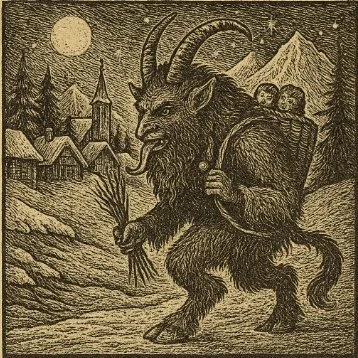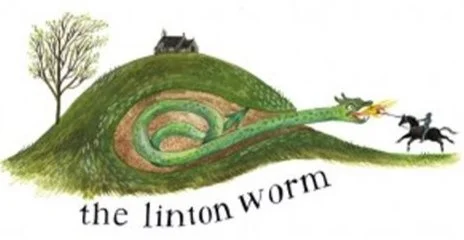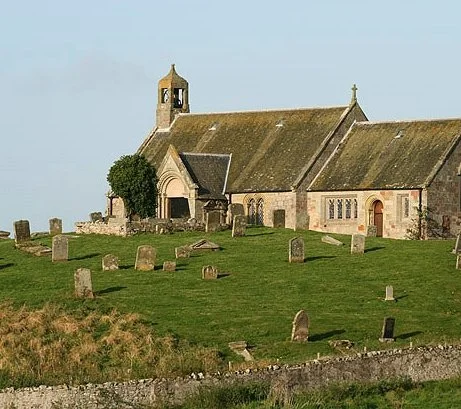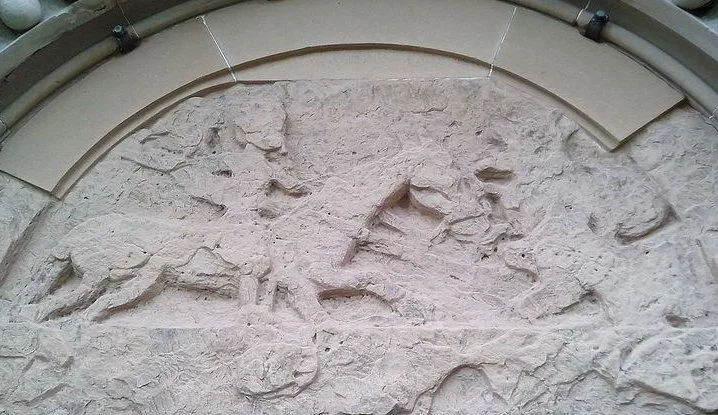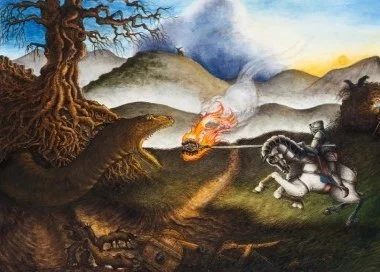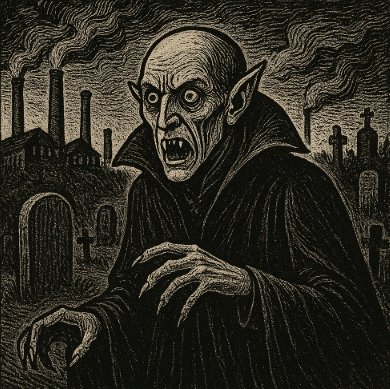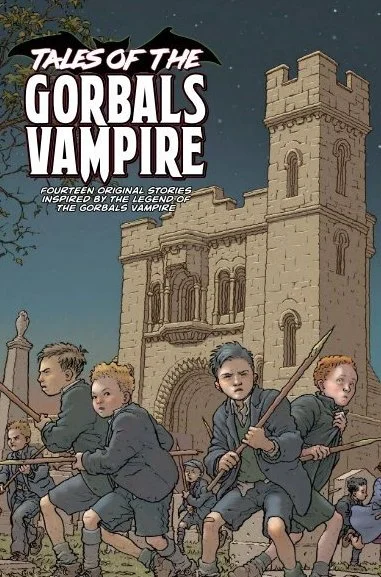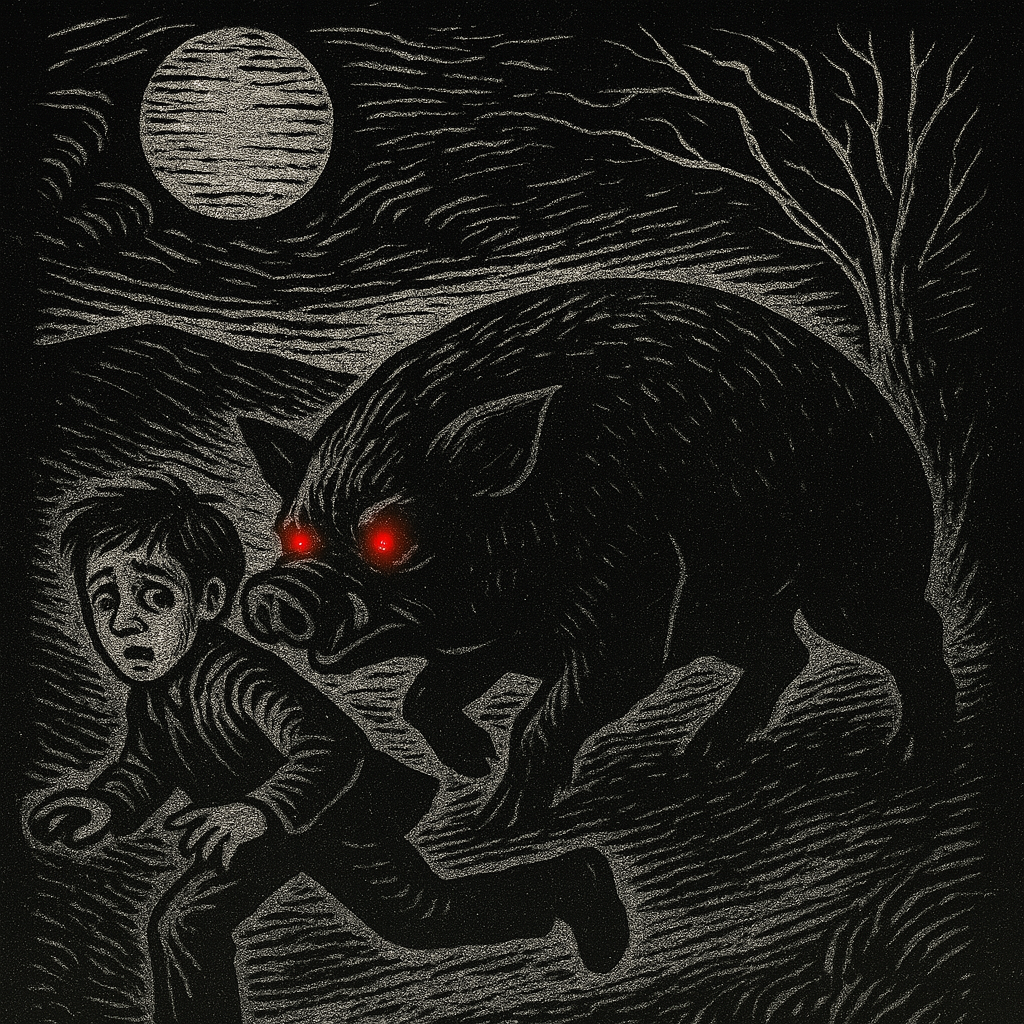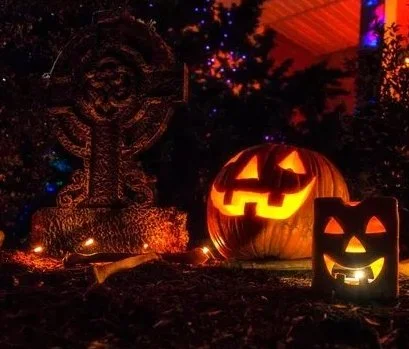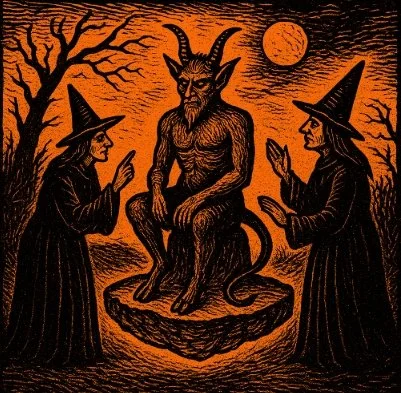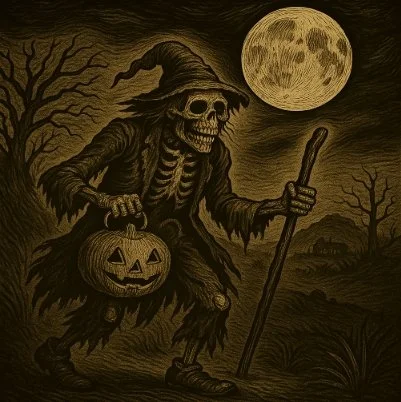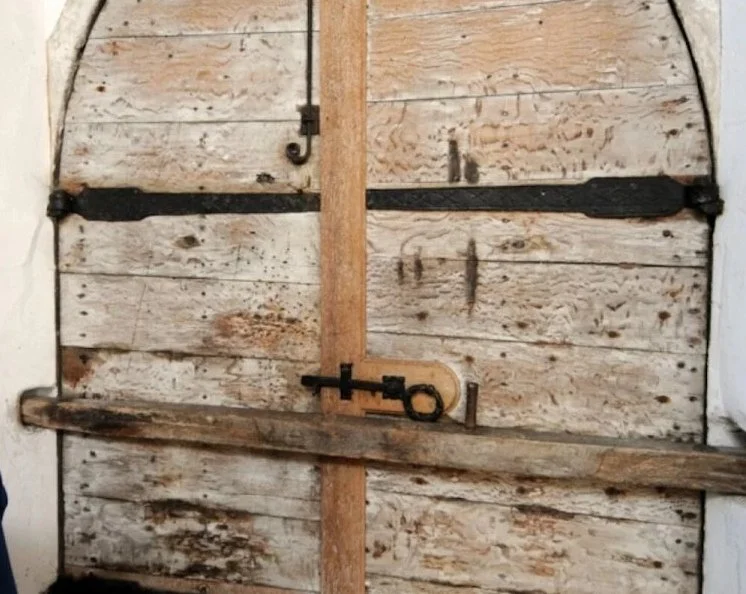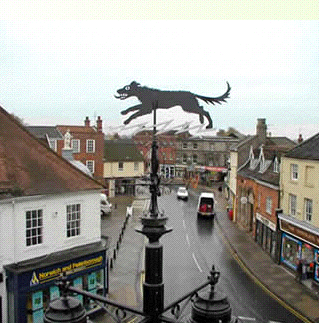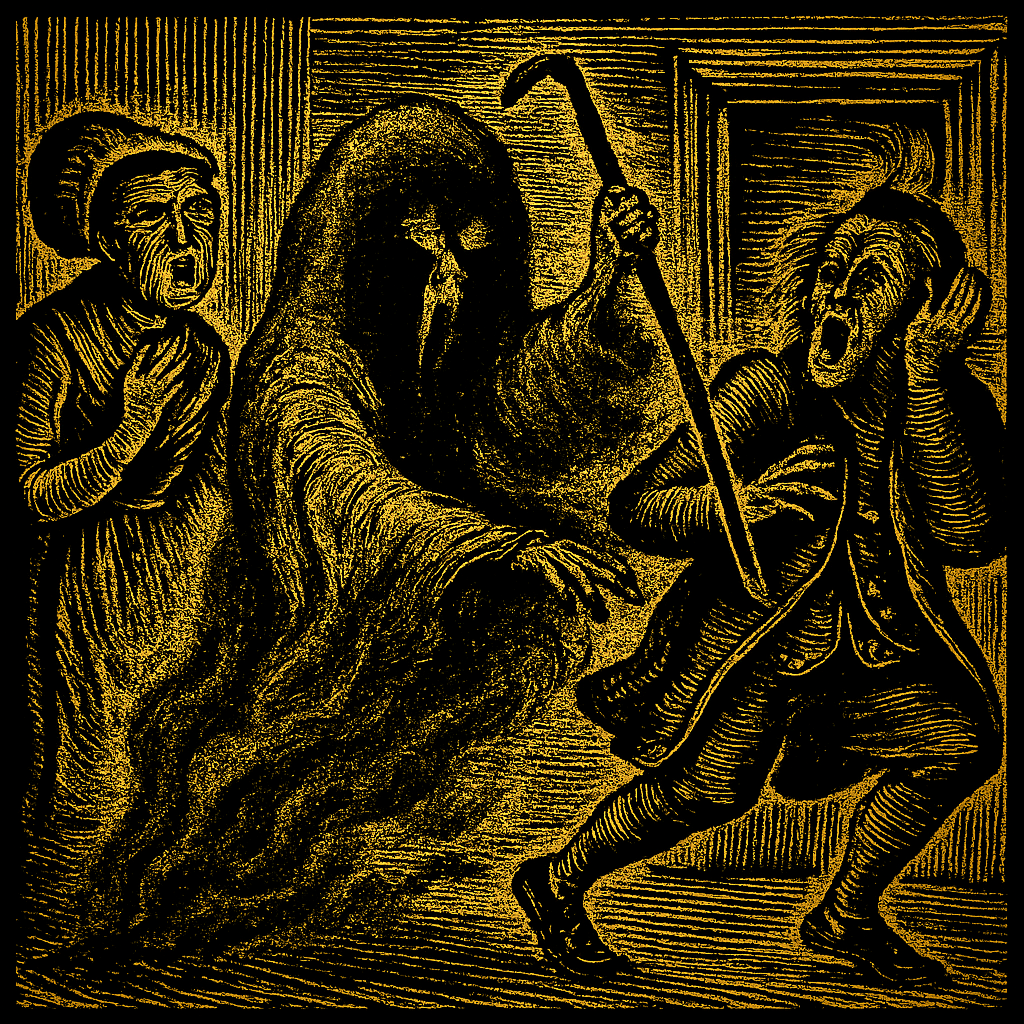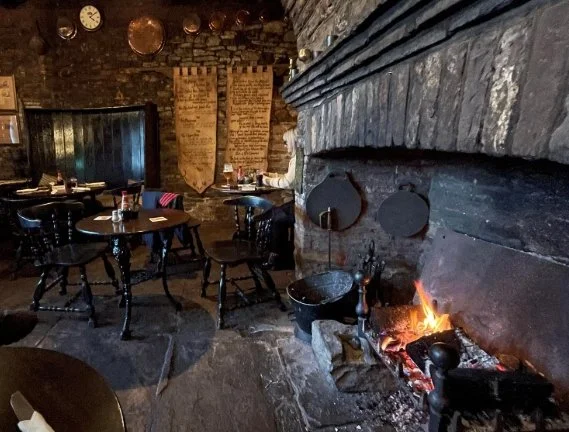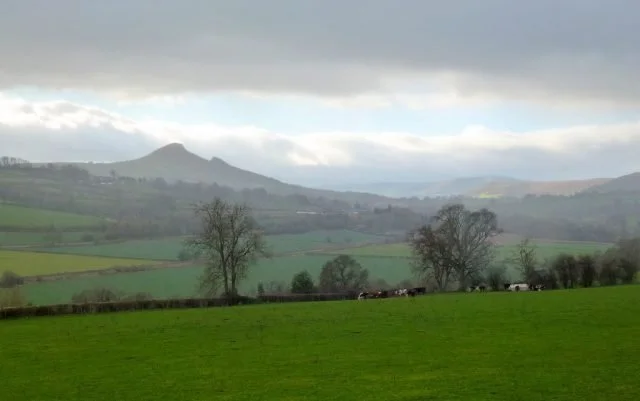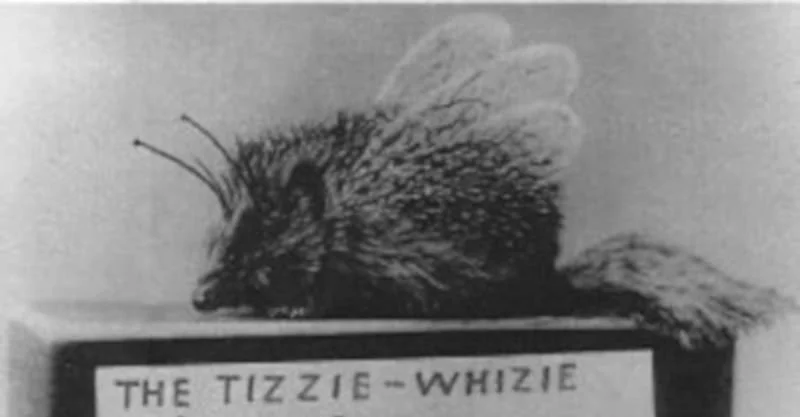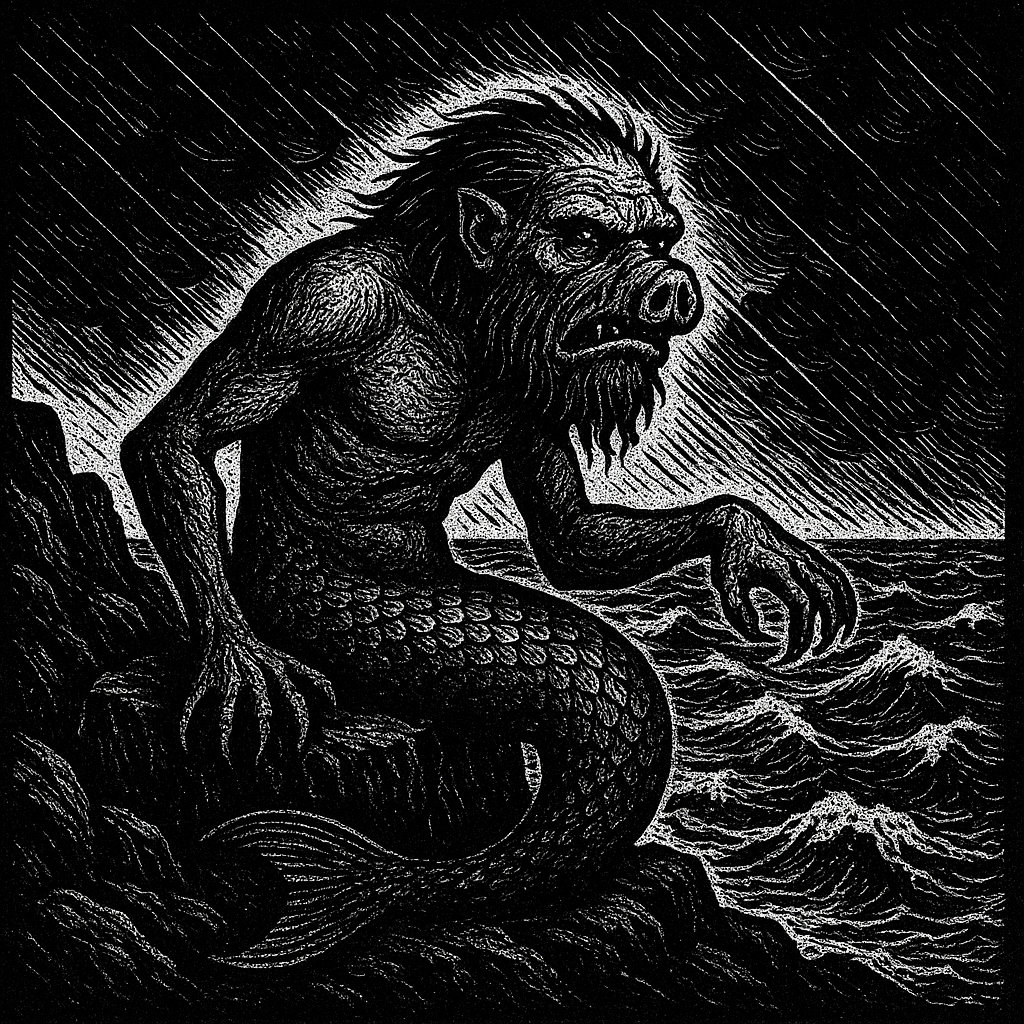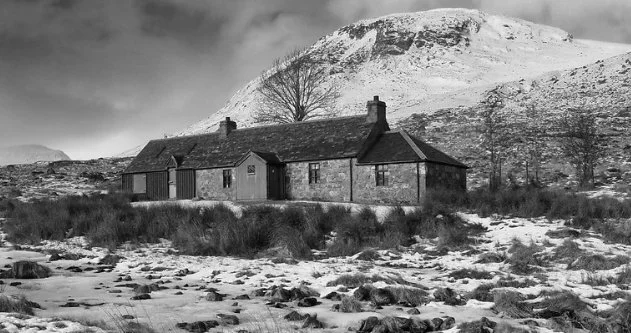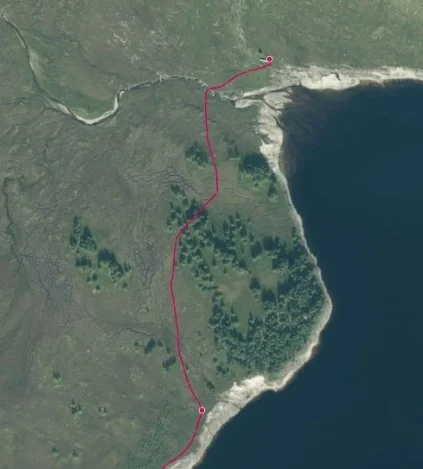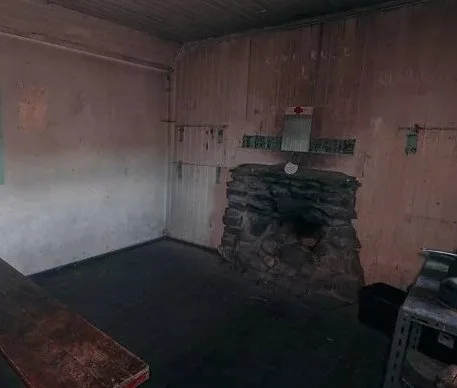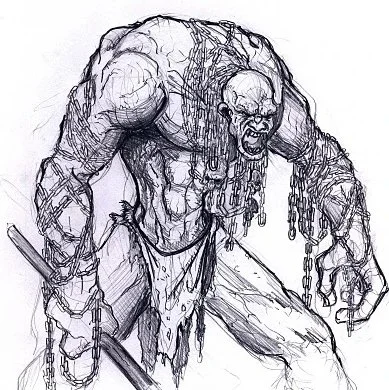Icelandic Folklore – Jólakötturinn, the Giant Yule Cat
The Yule Cat. Reader feel free in inset your own silly comment with the word Puuurfect in it.
The following Christmas legend was suggested to me last year by my old friend Andrew Fellows. My apologies, Andy, for taking so long to write it.
Iceland lies in the freezing ocean between the Arctic and the North Atlantic, described as a land of ice and fire. Its position on the Mid-Atlantic Ridge makes it one of the most volcanically active places on Earth. Lava fields, geysers, hot springs and frequent eruptions shape the landscape; around ten per cent of the country is covered in glaciers, and come winter the land lies beneath a blanket of white snow.
Iceland is therefore a place of great contrasts, rich in terrifying legends and unique Christmas myths. One such tale concerns a monstrous beast said to prowl the winter countryside every Christmastide: a creature of black fur, long of claws and with sharp fangs - the man-eating Jólakötturinn, the Yule Cat.
Jólakötturinn, also called Jólaköttur or the Christmas Cat, is believed to be the size of a small house and to possess glowing eyes capable of seeing through the darkest night and the thickest snowstorm. Good luck hiding from this hungry puss. She is considered the pet of the ogress Grýla and her sons, the Yule Lads. I have written a previous post about those thirteen little blighters, and I’ll leave a link to it here, if you want to know more about them. At some point I shall have to tackle the ogress herself - but that’s a story for another day. For now, back to our macabre feline.
The Yule Cat is believed to set forth on Christmas Eve and stalk the land, favouring as prey anyone who has not received new clothes for Christmas - especially children. These festive monsters do seem to enjoy targeting the younger generation.
Threatening the children does makes sense – another way to encourage little Timmy and little Sally to toe the line and behave at a time of year when excitement may tempt them to nail the furniture to the ceiling.
But why target those without new clothes?
This tradition is thought to stem from Iceland’s historic wool industry of the 17th to 19th centuries. Every household needed to complete the autumn shearing, carding, spinning and weaving before Christmas. The tale of the Yule Cat encouraged people, especially farm workers, to finish processing wool before the winter holiday. Anyone who did so would be rewarded with new clothes and therefore safe from the monstrous moggy.
In this way, the Yule Cat can be seen to represent Iceland’s harsh winter, a time when owning proper clothing was essential for survival. Scholars have also noted that cats are sacred to the Norse goddess Freya, whose chariot was said to be drawn by two great cats. How much this influenced the Yule Cat is difficult to say, but it is fun to speculate.
The belief in Jólakötturinn is undoubtedly an old one, but it was first recorded in writing in the 19th century when scholars began to collect the oral traditions of Icelandic farmers and labourers. Most notably, Jóhannes úr Kötlum helped popularise the creature in the 20th century with his famous 1932 poem Jólakötturinn. A translation of this poem is included below.
You know the Christmas Cat,
That cat is very large,
We don't know where he came from,
Nor where he has gone.
He opened his eyes widely,
Making both glow,
It was not for cowards,
To look into them.
His hair sharp as needles,
His back was high and bulgy,
And the claws on his hairy paw,
Were not a pretty sight.
Therefore, the women competed,
To rock and sow and spin,
And knitted colourful clothes,
Or one little sock.
For the cat could not come,
And get the little children,
They had to get new clothes,
From the grown-ups.
When Christmas Eve was lighted,
And the cat looked inside,
The children stood straight and red-cheeked,
With their presents.
He waved his strong tail,
He jumped and he scratched and blew,
And was either in the valley,
Or out on the headland.
He walked about, hungry and mean,
In hurtfully cold Christmas snow,
And kindled the hearts with fear,
In every town.
If outside one heard a weak meow,
Then bad luck was sure to happen,
All knew he hunted men,
And didn't want mice.
He followed the poorer people,
Who didn't get any new clothing,
Near Christmas – and struggled and lived,
In poorest conditions.
From them, he took at the same time,
All their Christmas food,
And also ate themselves,
If he could.
Therefore, the women competed,
To rock and sow and spin,
And knitted colourful clothes,
Or one little sock.
Some had got an apron,
And some had got a new shoe,
Or anything that was needful,
But that was enough.
For the cat should eat no-one,
Who got some new piece of clothes,
He hissed with his ugly voice,
And ran away.
If he still exists, I don’t know,
But for nothing would be his trip,
If next Christmas everybody got,
Some new rag.
You may want to keep it in mind,
To help if there is need,
For somewhere there might be children,
Who get nothing at all.
Perhaps looking out for those who suffer,
From lack of plentiful lights,
Will give you a good day,
And a merry Christmas.
Visitors to Iceland’s capital, Reykjavík, may encounter this terrifying cat in the form of statues, decorations and artworks. Just be sure to wear new clothes – Jólakötturinn is said to be sneaky, and what you assume to be a harmless monument to the deadly puss might, in fact, be the real thing. You would not want to meet this feline wearing last year’s knitwear.
Thank you for taking the time to read my blog. I hope this little piece of Christmas folklore has given you a pleasing shudder. If you enjoy what I do, please consider picking up a copy of my new anthology, Pocket Christmas Horror - a collection of seasonal spooky tales from some of the all-time greats, neatly packaged in a pocket-sized edition designed to sit comfortably in your coat or bag. Link below.
Alternatively, there are plenty of free stories, both written and audio, available in the download section of this website.
Until next week – stay spooky.
Sources
Wikipedia
historyextra.com
www.discoveryuk.com
genius.com (translated poem)
The Terrifying Legend of Krampus: Alpine Christmas Folklore Explained
Krampus, about his sinister business.
By the time the 5th of December arrives, children throughout the world are dreaming of brightly wrapped presents left in stockings or nestled beneath the gently glowing Christmas tree. But for the children of the Alpine region of Europe, this time was not one to be celebrated; it was a night to be feared, for the 5th of December is Krampusnacht (Krampus Night).
Krampus was largely unknown outside the Germanic/Alpine countries until around December 2014, when Austrian-German actor Christoph Waltz spoke about him during an interview on American television. Since then, his popularity - or perhaps I should say infamy - has spread rapidly.
Krampus’s name derives from the German word Krampen, meaning claw. He is described as a monstrous, half-goat, half-demon creature with a lolling red tongue, often depicted as being covered in thick hair. He wears a basket upon his back - a place to imprison any naughty children he manages to seize, for this Yule terror is an abductor of the young.
In his hands, he bears a Ruten, a bundle of birch sticks which he uses to swat and punish wrongdoers. He wears heavy chains, which he rattles loudly to announce his approach to terrified villagers; these chains are believed to symbolise the binding of the Devil in Christian tradition. Large cowbells are tied to his waist - another means by which he can be heard before he is seen. His equipment can vary slightly from region to region, and sometimes he is shown carrying a pitchfork.
Krampus is the devilish companion of St Nicholas, but where jolly old St Nicholas rewards the good, this hunched, leering devil punishes the bad, carrying off ne’er-do-well nippers in his basket. The ultimate fate of these miserable little lads and lasses depends upon the region. Usually, he will dish out a good beating with his Ruten, and children will awaken the following morning nursing welts and bruises. But those pint-sized wrongdoers may count themselves lucky, for the truly wicked are believed to be drowned, eaten, or even carried off to Hell.
Krampus is thought to have his origins in the ancient pagan rituals of the winter solstice. He is believed to be the son of Hel, the Norse god of the underworld, and despite the best efforts of the Catholic Church to ban him, he has survived through the centuries. It is quite possible that he is more popular now than he ever was before.
Festivals involving Krampus include the Krampuslauf (Krampus Run). Here, people parade through the winter streets dressed as the Alpine demon, terrifying spectators and even chasing them. The outfits of the participants are of excellent quality; the masks alone are often hand-carved and highly individualised, and very expensive to purchase. The parade is usually lit by torchlight, with strange, flickering shadows being thrown across the crowded streets.
During the late 20th century, in an effort to preserve cultural heritage, Krampus runs became increasingly popular. Today, Krampus is something of an icon, with many books and films about him. Some see the renewed popularity of Krampus as a backlash against the commercialisation of Christmas., and a return to something simpler that brings the community together.
I have often wanted to write my own Krampus story, but my commitments to completing the Wendlelow Mysteries trilogy have stayed my hand. However, with this project coming to an end, perhaps I shall find the time to turn my attentions to this horned menace, maybe I will have a Krampus tale ready to share with you my friend next Christmas.
So when you settle down to sleep this 5th of December, consider all the things you have done throughout the year. Have you been quite good enough? And remember - the jingling of bells does not always herald the arrival of Santa’s sleigh.
Thank you for taking the time to read my blog. I hope this little piece of Christmas folklore has given you a pleasing shudder. If you enjoy what I do, please consider picking up a copy of my new book, Threads of Shadow - link below.
Alternatively, there are plenty of free stories, written and audio, by yours truly, available in the download section of this website.
Until next week - stay spooky.
Folklore - The Linton Worm
The Linton Worm does battle.
The village of Linton can be found in Roxburghshire, in the Scottish Borders. It lies within the Cheviot Hills and is a site that has seen occupation since prehistoric times. It was once an Iron Age hillfort, and although time has greatly reduced the evidence of its defences; some of the earth ramparts are still visible.
Linton is a legend-haunted area and was, many years ago, said to be home to a terrible beast: a dragon-like monstrosity known as the Linton Worm or Wyrm. Wyrm is an Old English term for a serpent. The story of this terror, and its eventual downfall at the hands of one brave knight, was told by Sir Walter Scott in his Minstrelsy of the Scottish Border, Volume II (1802).
It is said that the grim beast dwelt in a darkened hollow of the earth on the north-east side of Linton Hill. It was described as being “in length three Scots yards and bigger than an ordinary man’s leg – in form and colour to our common muir edders”: roughly over nine feet long.
At dusk, it would crawl from its lair and slither about the land, terrorising the countryside, devouring cattle, crops, and even unlucky night-time travellers, before vanishing back into its den before sunrise. According to the legend, a few attempts were made to kill it, but normal weapons seemed unable to penetrate the armour of its hide. Thus Linton and the surrounding lands were ravaged by the beast, and gradually the area began to fall into ruin.
Stories of the wyrm and the terror it caused eventually reached the ears of the Laird of Lariston, one John de Somerville, a knight of the realm with a reputation for reckless bravery. Such a man was drawn to the beast like iron to lodestone. He journeyed to the nearby town of Jedburgh, where he rested awhile in a local tavern and listened to the folk whisper tales of the monster, over their foaming cups of ale.
Though brave, he was a canny fellow, and decided to observe the beast before confronting it. That evening, he concealed himself in an ancient grove of trees near the creature’s lair and watched. As the sun’s rays disappeared behind the horizon, and light mists rose up from the ground, it came crawling from the earth. He observed that when it approached its prey, it opened its mouth wide to swallow the doomed victim whole.
An so, idea began to form in the knight’s mind.
The next day, he had a blacksmith craft him an iron lance, upon the end of which he fixed a lump of peat coated in tar and brimstone.
That evening, he rode back to the beast’s lair and waited. Again, as the sun dipped below the misty hillside, the creature emerged. The knight ignited the sticky mass on the end of his lance, then charged. The great wyrm opened its mouth, intent on swallowing both knight and steed, but the flaming lance was driven deep into its throat.
The writhing death-throes of the Linton Worm supposedly created the curious topography of the hills in the area, a place that became known as “Wormington”. The wounded creature retreated into the darkness of its lair to die, its thrashing tail bringing down the hillside behind it and burying it forever.
The legend states that de Somerville’s heroism was memorialised by a carved stone at Linton Kirk. He was raised to the position of Royal Falconer, knighted, and made “First Barrone of Linton” in recognition of his deed, and the family crest of the Somervilles became a wyvern.
Finally, the good folk of Linton could sleep easy in their beds.
Thank you for taking the time to read my blog, my friend. I do hope you enjoyed this tale of a dashing knight and his battle against a terrible predatory beast.
I have also recently released a short book for charity, Big Dawg and the Great Walkies Sweepstake. It is a mere 80 pages long and small enough to sit comfortably in a pocket or handbag. The book is a comedy/farce greatly influenced by the work of one of my favourite writers, P. G. Wodehouse, and is entirely family-friendly. All profits will go to a local charity, the Mary Stevens Hospice, whose wonderful staff supported my friend and his family at a very difficult time. I do hope you consider picking up a copy and supporting this worthwhile cause. This little book would make a wonderful Christmas stocking filler.
Link below and Blurb below..
Many thanks,
See you next week - and stay spooky
BIG DAWG - and the Great Walkies Sweepstake.
By P. A. Sheldon
Big Dawg never meant to cause chaos at Poshington Place – honestly. All he wanted was a quiet weekend, a decent breakfast, and perhaps the odd flutter on the elderly ladies’ dog-walking.
Instead, he ends up battling a scheming rival, rescuing the wrong dog, becoming engaged by accident, and relying on a disgruntled Neapolitan mastiff to save him from matrimony.
With Pedro’s terrible ideas and Millhouse’s impeccable damage control, Big Dawg stumbles through a weekend of aristocratic mayhem, canine melodrama, and romantic misfires.
A hilarious country-house caper for fans of Wodehouse, sausage rolls, and badly behaved dogs.
Sources
Wikipedia
Folklorescotland.com
Dscoverscottishborders.com
Irish Folklore – The Fearful Far Darrig.
A Far Darrig - Beware the sound of strange laughter in the night.
There are many different Aos Sí - fairy folk - in Irish folklore. The whole country is rich with legends of these strange beings: some benevolent and helpful to humans, others darker and more solitary. It is to this latter group that the Far Darrig belong.
Tales of the Far Darrig and their mischief can be found throughout Ireland, though these troublesome goblins are most common in the west and south, particularly in the counties of Cork, Clare, and Kerry.
In Irish, the Far Darrig are known as Fear Dearg, meaning “Red Man”, a reference to their fondness for red clothing. They are sometimes called “Rat Boys”, as they are believed to have dark, hairy skin, long snouts, and thin tails. Depending on the source, these rattish qualities may be understated, giving them a more human appearance - but whatever form they take, they are regarded as eaters of carrion.
Of the many solitary and ill-natured fairies that haunt Ireland’s shores, there are few more wretched than the Far Darrig. He is believed to preside over evil dreams. Some stories claim he was once a mortal man who stumbled into fairyland by mistake and now tries - through tricks and warnings - to prevent others from making the same mistake.
Most active during winter, the Far Darrig delights in startling unsuspecting households by banging on their doors in the dead of night, demanding entrance and a place by the fire. To refuse such a request was considered perilous: you might awaken to find your child stolen and a changeling left in its place, or discover that your cattle had mysteriously sickened.
Should you ever encounter a Far Darrig, you would be wise to treat him with the utmost politeness, lest you fall victim to one of his cruel practical jokes. A favoured trick is to persuade an unwitting person to carry a corpse on their back and, in a gruesome twist, convince them it is merely meat, urging them to roast it on a spit.
One tale tells of a Far Darrig who disguised himself as a farmer and tricked a group of men into helping him harvest his field. They laboured diligently, only to discover that they had been gathering pebbles rather than grain. The Far Darrig, delighted with his deception, vanished into thin air, leaving the men thoroughly bewildered.
Another story describes the Far Darrig leading a band of travellers astray in the mountains. He coaxed them into a bog, where he entertained them with wild tales and strange songs. As the travellers grew increasingly intoxicated, the Far Darrig slipped away, leaving them stranded in the marshy darkness.
So take care when wandering Ireland’s lonely places, and listen closely for laughter carried on the wind. This is one creature you would do well not to meet - especially alone.
Thank you for taking the time to read my blog. I hope you enjoyed this little legend from the Emerald Isle. With the festive season rapidly approaching, if you’re a lover of classic Christmas ghost stories, I’ve compiled a collection of some of the finest seasonal tales of terror ever told - Pocket Christmas Horror. It makes the perfect companion for these long, dark evenings. Please consider picking up a copy-link below.
Alternatively, you’ll find plenty of free stories, written by yours truly, in the downloads section of this website.
Until next week-stay spooky.
Sources
Wikipedia
OxfordReference.com
HorrorChronicles.com
BellaTerreno.com
Urban Folklore – The Gorbals Vampire
The Gorbals Vampire…
Within the Scottish city of Glasgow, on the south bank of the River Clyde, there can be found the Southern Necropolis, a sprawling Victorian cemetery, within a district called the Gorbals. It is thought the name Gorbals may come from the ecclesiastical Latin word garbale (“sheaf”) and relate to corn tithes that had to be paid to the Church, the Gorbals therefore meaning “the Sheaves.”
By the late 19th century, a mass migration from rural areas of Scotland and Ireland by people looking for work within the city saw it become a densely populated working-class area, with much poverty. But one particularly notorious resident, who stalked the area in the 1950s, has gone down in folklore. And this was a Vampire.
The Southern Necropolis is certainly a place with plenty of atmosphere - old, lichen-crusted graves and tombs huddle together, behind which could be seen a large factory: the Dixon Blazes steelworks, which vomited forth flames and black clouds of smoke into the sky both day and night. Just the sort of place any self-respecting vampire might choose to reside.
This Gorbals Vampire was described as a towering monster with red eyes and iron teeth. The local schoolchildren believed he prowled the graveyard at night, sometimes even wandering the streets in search of victims, it was even whispered that he was responsible for the deaths of two youngsters. Exactly who first started this rumour, history does not record, but it soon became the talk of the playground.
Most children, faced with such a terrible horror stalking the darkness, would lock themselves away of an evening, ensuring their parents bolted all doors and that the windows were tightly fastened.
But not the youth of the Gorbals.
These little nippers were made of sterner stuff; they were not content to cower away. One evening in September 1954, hundreds of children took to the streets armed with homemade stakes and knives, some accompanied by large, excitable dogs. These pint-sized monster hunters gathered in the cemetery, determined to put an end to the undead fiend who stalked their district. They ranged from teenagers to very young children - one four-year-old was reported among their number, though whether he was armed I cannot say! The crowd was so large that the police had to be called to break it up.
The monster hunt continued for several nights, despite the authorities’ best efforts, and some children even claimed to have seen the vampire, which they described as a dark figure lurking amongst the graves and shadowed stone angels, burning red eyes watching them with sinister intent.
Eventually, the panic ran its course and, over time, the excitement died down. But the story made national headlines, with newspapers describing it as “mass hysteria” or “moral panic.” People blamed American horror comics. In response to the uproar, the British government introduced the Children and Young Persons (Harmful Publications) Act of 1955, effectively banning violent comics that were seen as corrupting youth. This was one of the earliest instances of media-driven moral legislation in post-war Britain.
Today, there are many theories about the origin of the monster. Some suggest the “vampire with iron teeth” may have originated from biblical imagery - Daniel 7:7 speaks of a beast with “great iron teeth.”
Others think it was inspired by “Jenny wi’ the Airn (Iron) Teeth”. She was said to have been a hideous witch who prowled around Glasgow Green in the 1800s, with a reputation for devouring children who refused to go to sleep. A rhyme was written about her:
Jenny wi’ the Airn Teeth
Come an tak’ the bairn (child)
Tak’ him to your den
Where the bowgie bides (bogie lives)
But first put baith (both) your big teeth
In his wee plump sides.
Though no vampire has been reported in the Gorbals for many years now, and urban regeneration has greatly changed the area, you can still visit the Southern Necropolis- though I would only recommend doing so by the light of day.
Thank you for taking the time to read my blog. I hope this little piece of Halloween folklore has set you trembling with pleasurable fear. If you enjoy what I do, please consider picking up a copy of my new book, Threads of Shadow - link below.
Alternatively, there are plenty of free stories, written by yours truly, available in the download section of this website.
Until next week — stay spooky.
Sources:
glasgowworld.com
Wikipedia
spookyscotland.net
scotsman.com
Horrific Folklore – Black Annis the Murderous Hag.
Black Annis - Evil Hag or Goodly Nun?
The Dane Hills can be found in the county of Leicestershire, in the English East Midlands. The area is understood to be so named because it was the site of a Viking encampment around 877 AD. Deep within this windswept countryside lies a lonely cave known as Black Annis’ Bower – a place of grim repute, whispered to be the lair of a witch or hag who goes by that name.
Black Annis, also known as Black Agnes or Black Anna, was not merely a lonely old woman trying to eke out a living on the edge of society. Her reputation was such that there are few other entities within English folklore that are considered as deadly and fearsome.
The unfortunate old time witnesses who claimed to have seen this hideous crone described her as a blue-faced hag with claws of iron and a murderous taste for human flesh – most especially the flesh of children. As with so many terrifying beings of folklore, Black Annis was a sort of bogeyman – or, more precisely, bogeywoman – used to terrify any wayward child into good behaviour.
The isolated residents of the Dane Hills would whisper of her emerging from her cave at night and roaming the hills in search of victims. Usually, this would be cattle left out to pasture, but should she stumble upon a cottage, she was said to reach through the window and drag out her victim, carrying them off to her bower.
The legends state that this bower was dug from the cliff by her own hands, tearing into the sandstone with her iron claws. One piece of folklore stated that when Black Annis ground her teeth, the noise of it would carry for miles on the wind – a sign that she was about her dark business – and cottagers would know to lock their doors, shutter their windows, and bank the flames in the fireplace high. It was rumoured that cottages built close to her lair were given small windows, and that the residents would employ a little folk magic, hanging protective herbs over them to keep the hag at bay.
English historian Ronald Hutton has suggested that the legend might stem from a real person, Agnes Scott, a Dominican nun who cared for a community of lepers in the area. It is thought this devout woman dwelt in the cave, and that, over the centuries, memories of her good deeds became warped and corrupted.
Many of the modern conceptions of Black Annis were popularised in a poem by John Heyrick, given in full in County Folklore (1895), an excerpt of which I give below:
’Tis said the soul of mortal man recoiled
To view Black Annis’ eye, so fierce and wild;
Vast talons, foul with human flesh, there grew
In place of hands, and features livid blue
Glared in her visage, whilst her obscene waist
Warm skins of human victims close embraced.
Not without terror they the cave survey,
Where hung the monstrous trophies of her sway;
’Tis said that in the rock large rooms were found,
Scooped with her claws beneath the flinty ground.
It was also supposed that Black Annis could take the form of a monstrous cat, and this led to a local ritual in early spring, where a dead cat would be dragged before a pack of hounds in front of her bower to celebrate the end of winter.
The earliest known written reference to Black Annis comes from an eighteenth-century title deed that referred to a parcel of land as “Black Anny’s Bower Close”, dated 13th–14th May 1764. There is some debate as to the exact location of Black Annis’ cave, though one of the most widely attributed sites is a cave in woodland close to the village of Scraptoft.
Perhaps you, dear friend, will be brave enough to explore these woods, to seek out the cave and venture into that dark recess in the earth. Perhaps you might share your adventure with us, should you return!
Thank you for taking the time to read this blog, my friend. As a token of my gratitude for your support, I have a few free scary stories for you to enjoy over this dark season — please visit the download section.
If you favour something more substantial, click the link below and pick up a copy of my latest book, Threads of Shadow. But fair warning - if you do, prepare to be horrified.
Until next week - stay spooky.
Links
Sources:
mythologyplanet.com
hiddengemsleics.co.uk
Wikipedia
The Leiscester Chronicle
HALLOWEEN FOLKLORE – THE PHANTOMS OF NETLEY ABBEY
There is more than one ghost at Netley Abbey…
The ancient Abbey of Netley now lies in ruins - like so many British abbeys - after King Henry VIII seized it during the Dissolution of the Monasteries in the 1530s. Over the years the building has fallen into its current sad, if not romantic, state.
Netley Abbey is located in the county of Hampshire in the south-east of England. It was founded in 1239 by Peter des Roches, the Bishop of Winchester, for the Cistercian order.
There are many legends and stories associated with this lonely ruin, but one in particular is directly linked to the date 31 October - Halloween.
The story told in the area is that anyone who dares to enter the ruins on this most bleak of evenings had best beware, for the phantoms of three misty women are said to appear upon the walls of the abbey, wandering silently, silhouetted against the skyline. All around the crumbling building the ghostly sound of church bells can be heard, carried on the night breeze. Who these women are, or why they walk on this night, is not known - but local folk know to avoid the place on Samhain evening.
Yet the spectral ladies are not the only horrors that lie waiting within the abbey. There are also tales of Blind Peter, another phantom most often sighted around Halloween. He is believed to be the ghost of a monk who roams the ruins and is linked to stories of treasure buried somewhere within the site.
When King Henry VIII took control of the monasteries in the sixteenth century, he claimed their considerable wealth for the Crown. To prevent this happening to their own riches, the monks of Netley are said to have hidden their valuables in a secret passage, sealing them away with one monk left behind to guard them - the unfortunate Blind Peter.
Over the centuries many have tried to find this treasure, but only one man ever came close. His name was Slown.
He reportedly discovered the hidden passage and entered it, while his friends waited anxiously outside for his return. After a long time, he staggered from out the darkness, his face grey and his eyes wild, and fell to his knees before them. He managed to gasp the words, “Seal it up!” before dropping dead at their feet.
Another tale tells of a builder named Walter Taylor, who was commissioned to demolish part of the monastery church. The night before the job was due to be started, he told his wife of a terrible dream in which he was warned that he would pay for his sacrilege with his life if he went ahead with the work. Foolishly, he dismissed the warning - and with a fatal inevitability - he was killed the very next day by falling masonry.
Finally, there are two modern witness accounts of Netley’s ghostly denizens. The first came from a Mrs Neal, who in 1970 claimed to have seen a tall, lean figure in a dark brown cloak with its hood drawn low over the face, beckoning her slowly towards the abbey grounds. Then, in 1981, two people camping within the ruins reported being woken in the night by a “sinister force” that caused a sudden drop in temperature and seemed to linger around their tent. Their dog growled continuously and refused to leave their side to confront the unseen visitor.
Today, Netley Abbey is cared for by English Heritage and welcomes all visitors - both the living and, perhaps, even the dead.
Thank you for taking the time to read my blog. I hope you’ve enjoyed this piece of Halloween folklore. If you did, please consider picking up a copy of my new book Threads of Shadow - link below.
Alternatively, there are plenty of free stories, written by yours truly, available in the download section of this website.
Until next week - stay spooky.
Sources .
The National Trust Website.
Hampshire Live.
davidfarrant.org.
Wikipedia.
Halloween Folklore – The Terrifying Black Tailless Sow
The Tailless black sow - a very effect way to enforce curfew rules…
In Wales, the first day of winter is called Calan Gaeaf — the 1st of November. It is a grey day, marking the beginning of a long, cold struggle through the frozen season, with the dim light of spring but a distant dream.
Nos Calan Gaeaf is the name the Welsh give to the 31st of October - Halloween. Along with all the usual connections to witches, devils, and boggarts, it was considered a Ysbrydnos (spirit night). Traditionally, people would avoid stiles, churchyards, and crossroads on this night, as it was thought that all manner of ghosts would gather in these lonely places.
Nos Calan Gaeaf was also a time when rural communities came together. The night would be filled with feasts, apple bobbing, and large village bonfires. It was a harvest festival, and one popular game in rural communities was called Caseg Fedi – The Harvest Mare. The last bit of corn was not harvested but tied up in the middle of the field. This was the Caseg Fedi, and the menfolk would take turns to throw their sickles at it; the one to cut it down was the winner. Great sport was made with it, throwing it into neighbours’ fields or trying to sneak it into people’s homes.
But there was a black legend associated with this the most shadowed night of the year - that of Hwch Ddu Gwta, the Black Tailless Sow.
She is described as a huge, terrifying black pig - tailless and with glowing red eyes. Sometimes she was accompanied by Y Ladi Wen heb ddim pen, the White Headless Lady. They haunted the lanes and fields about Welsh villages, and children were warned not to stray too far from home and to be back indoors well before dusk, for should they encounter the Black Pig, it would chase them down and attempt to gobble them up.
There was a fearful chant associated with this demonic porker; it went like this:
“Adref, adref, am y cyntaf,
Hwch ddu gwta a gipio’r ola’.”
“Home, home, at once,
The tailless black sow shall snatch the last one.”
As the village bonfire died down, there was a tradition in some parts of Wales that children would gather around it, chanting this dreadful verse. Then a villager, wearing a pigskin, would take on the role of the Black Sow, leaping through the fire’s dying flames to chase the children home.
So, should you ever find yourself wandering the Welsh countryside on the 31st of October, and hear a distant snuffling and grunting carried on the autumn wind – turn about and hurry home. It might just be a regular Pig… but it might be something far more sinister and threatening.
Thank you for taking the time to read my blog. I hope this little piece of Halloween folklore set you trembling with a pleasurable fear. If you enjoy what I do, please consider picking up a copy of my new book, Threads of Shadow — link below.
Alternatively, there are plenty of free stories, written by yours truly, available in the download section of this website.
Until next week — stay spooky.
Halloween Folklore – The Devil’s Cradle
Auld Nick about his business…
Welcome back, friends. As promised, today I bring you another piece of strange Halloween folklore - this time featuring that international mischief-maker, Auld Nick (the Devil).
The village of Dollar can be found in the county of Clackmannanshire, in central Scotland, about twelve miles east of the city of Stirling. Despite its name, Dollar has no connection with the currency. It is thought the name may originate from Scots Gaelic, meaning “dark” or “gloomy”, or possibly have Pictish roots and mean “a water meadow”.
Not far from this little village lies Burngrens Glen, a wooded area with a stream that bubbles pleasantly beneath its shady boughs. Within this lonely glen can be found a stone shaped like a cradle - it is a place with a grim reputation, and rightly so, for it is believed to be where witches and warlocks gather to perform sinister rituals on dark nights. But the glen is also believed to have a worse visitor than even these dark-hearted magicians, for every Halloween it is said to be visited by the Devil himself.
People are advised to stay away from the area on the night of 31st of October. For it is then that the stone cradle is said to swing back and forth in mid-air with nothing holding it up. Seated snugly within it is “Old Sandy” - a local nickname for the Devil - enjoying being rocked by his followers from the witch cult. They spend all night with “Old Sandy” until sunrise sends them on their way, not to be seen again until the next Halloween night.
It would be a foolish person indeed who ventured there on that particular night of the year - and yet, according to local legend, someone once did. Here is his story:
One Halloween night, a young man who had been drinking with his friends and boasted in front of them that he would visit the stone alone. Taking a bottle of whisky to give him some Dutch courage, he soon set out.
The stone was not far away, so he reached his destination quickly. After a good gulp of whisky, he sat down on the cradle-shaped stone, determined to dispute its rightful ownership should the Devil appear and claim it as his seat.
Every rustle of a leaf, as the wind whistled through the glen, seemed to the young man to herald the Devil’s approach, so he took a few more gulps of John Barleycorn. However, due to the amount he drank, he soon fell asleep upon the stone.
His friends, who had followed him, approached the sleeping man. Shouting and making loud noises, they grabbed him and carried him, half-awake, to the burn. They dipped him in repeatedly, and every time he was immersed in the water, they yelled loudly. The young man, in his drunken and sleepy state - thinking a whole legion of devils surrounded him - was frightened almost to death. He screamed for mercy so pitifully that his friends soon stopped their mischief.
No sooner had the young man got to his feet than he rushed off up the glen and ran home, resolving never to drink again or attempt to toy with the Devil. For a long time, he did not know it had been his friends who had tormented him.
I wonder if anyone today would be brave enough to venture down into the glen on that night of black repute — and if they did, what might they see?
Thank you for taking the time to read this blog, my friend. As a token of my gratitude for your support, I have a few free scary stories for you to enjoy over this dark season - please visit the download section.
If you favour something more substantial, click the link below and pick up a copy of my latest book, Threads of Shadow. But fair warning - if you do, prepare to be horrified.
Until next week — stay spooky.
Sources
The Ochils: Placenames, History, Tradition – Angus Watson (1995)
Wikipedia
clackmannanshire.scot (accessed 10th December 2023)
Halloween Folklore – Stingy Jack & The Jack O’Lantern
Stingy Jack & his Jack O’Lantern...
The month of October is upon us; it is the season of mists and mellow fruitfulness. The cold wind nips the leaves on the trees, turning them scarlet, brown and orange, and Halloween bears down upon us like a spectral freight train. Sorry - getting a bit carried away - but I do love the autumn. The spooky festival is an old favourite of mine.
Anyway, I digress. As a nod to Halloween, throughout this dark month I’ll turn my blog towards some seasonal folklore. Let us begin with the legend of Stingy Jack.
There can be few things more closely linked to Halloween than the Jack O’Lantern. These carved pumpkins are to this celebration what decorated pine trees are to Christmas - except that they are scarier, and have a much darker origin story. To learn about it, we must travel back in time to the mist-shrouded hills and woods of Ireland.
Stingy Jack, also known as Jack the Smith, Drunk Jack, Jack-o'-lantern and Pumpkin Jack, is an old tale told beside winter fires in Irish cottages, or muttered about in warm taverns to scare locals on their journey home. It goes something like this:
Jack was a drunken blacksmith, and what we in business might call a bit of a wrong ’un. One day he uncharacteristically decided to help an old man, who turned out to be an angel. As a reward, the angel offered Jack three wishes.
This was a mistake.
Rather than use the wishes to better his lot - or better still to perform acts of charity, which would no doubt have been the angel’s chosen preference - Jack decided to use his wishes to punish anyone who sat in his chair, took wood from his tree, or tried to take his tools.
The angel, naturally disappointed, punished Jack by preventing him from entering Heaven.
Enter the Devil.
Jack was drunk and wandering through the countryside at night when he came upon a body on the cobblestone path. It had an eerie grimace on its face and turned out to be the Devil himself. Jack realised this was his end, so he made a final request: to have one last drink of ale before being dragged to Hell.
Satan took Jack to the local pub. Upon quenching his thirst, Jack asked the Devil to pay for the ale. Jack convinced him to turn himself into a silver coin to pay the bartender, and to change back once no one was looking. Satan did so - possibly impressed by Jack’s unyielding cunning.
Shrewdly, Jack slipped the now-transformed Devil (in coin form) into his pocket, which also contained a crucifix. The crucifix’s presence kept the Devil trapped, unable to escape. To win his freedom, Satan was forced to agree to Jack’s demand: in exchange for his release, he must spare Jack’s soul for ten years.
Ten years passed, and the Devil once more appeared. As Satan once more prepared to take him to Hell, Jack asked if he could have one last apple, as he was hungry. Satan - who clearly had not learnt his lesson the first time - climbed up the branches of a nearby apple tree. Quickly, Jack surrounded the tree with crucifixes. Frustrated at being entrapped yet again, the Devil demanded his release. This time, Jack demanded that Satan should never take his soul to Hell. Reluctantly, the Devil agreed and was set free.
When Jack finally died, he found that he was barred from both Heaven and Hell, and was forced to wander the earth as a spirit, with only a glowing ember in a carved turnip to light his way.
It has been suggested that this is the origin of the Jack O’Lantern, though scholars have also proposed that such carvings could be connected to ancient Celtic head cults.
Much like Jack, the people of Ireland created their Jack O’Lanterns from turnips and other root vegetables. I made one from a turnip when I was a boy and it was bluming hard work to carve the thing!
Fortunately, America had the answer: pumpkins - much easier to hollow out and carve, whilst also providing a pleasing orange glow.
A Jack O’Lantern is also another name for a will-o’-the-wisp, those mischievous spirits seen around bogs and marshy lands. It’s easy to imagine a lonely traveller on a dark Halloween road seeing such a light dancing about, imagining it to be Jack and his turnip lantern roaming the countryside.
Thank you for taking the time to read my blog, my friend. I want to give a huge thank you to my wonderful wife, who takes the time to read and edit my posts - without her hard work, the whole thing would be total gobbledygook.
FINALLY – FREE BOOK ALERT
From now until 8th October, my new book Threads of Shadow will be available free on Kindle - so don’t delay, download your copy today. Then curl up by the fire and prepare for some pleasing chills. It’s the perfect Halloween read.
Links below.
Stay Spooky.
Sources
www.carnegiemnh.org
The Very First Halloween Jack-O’-Lantern, Bill Russo, 2017
Wikipedia
Black Shuck – The Grim English Devil Dog.
Black Shuck - Scratching to get in.
East Anglia is an area of south-east England which includes the counties of Norfolk, Suffolk and Cambridgeshire; some parts of Essex are also considered to belong to the region. Its name comes from the Anglo-Saxon kingdom of the East Angles, whose people originally came from northern Germany, from an area called Angeln — a peninsula on the coast of Jutland.
East Anglia is claimed to be home to a ghostly black dog that haunts the coastline and countryside of the region. Referred to by the local folk as Black Shuck, Old Shuck, or simply Shuck, he is described as a huge beast, often the size of a pony or even a fully grown horse. The name “Shuck” likely comes from the Old English scucca or sceocca, meaning “demon” or “devil”, though some have suggested it could also derive from shucky, meaning shaggy.
A printed account of the beast appears in 1850, when Reverend E. S. Taylor described him in the journal Notes and Queries:
“Shuck the Dog-fiend: this phantom I have heard many persons in East Norfolk, and even Cambridgeshire, describe as having seen as a black shaggy dog, with fiery eyes and of immense size, and who visits churchyards at midnight.”
Perhaps the best-known description, however, comes from Highways & Byways in East Anglia by W. A. Dutt (1901):
“He takes the form of a huge black dog, and prowls along dark lanes and lonesome field footpaths, where, although his howling makes the hearer’s blood run cold, his footfalls make no sound. You may know him at once, should you see him, by his fiery eye; he has but one, and that, like the Cyclops’, is in the middle of his head. But such an encounter might bring you the worst of luck: it is even said that to meet him is to be warned that your death will occur before the end of the year. So you will do well to shut your eyes if you hear him howling; shut them even if you are uncertain whether it is the dog-fiend or the voice of the wind you hear. Should you never set eyes on our Norfolk Snarleyow you may perhaps doubt his existence, and, like other learned folks, tell us that his story is nothing but the old Scandinavian myth of the black hound of Odin, brought to us by the Vikings who long ago settled down on the Norfolk coast.”
Witnesses who have encountered Old Shuck often describe an aura of dread. He is said to appear silently, padding up behind travellers on dark lanes or waiting in the shadows at crossroads, his single eye blazing like an infernal lantern. As A. W. Dutt points out he is usually considered a death omen, and so the thought of meeting him filled the local people with fear. However, on rare occasions, he is described as escorting the witness - perhaps even protecting them from some unseen threat.
The most notable of his appearances was said to have occurred on 4th August 1577, recorded that same year by Abraham Fleming in A Straunge and Terrible Wunder.
Fleming describes how Black Shuck burst through the doors of Holy Trinity Church at Blythburgh. His arrival was marked by a clap of thunder; he ran up the nave past the terrified congregation, killing a man and a boy as he did so and causing the steeple to collapse. As the dog departed, he left scorch marks on the north door, which can still be seen at the church today. (See photos.)
On the same day, the beast is said to have appeared again - this time at St Mary’s Church in Bungay. Once more, he broke into the church during a religious service, running among the kneeling worshippers, biting heads and breaking necks before vanishing again.
Other accounts attribute these events to the Devil himself, and the scorch marks on the door are still referred to by local people as the Devil’s fingerprints, commemorated in the following verse:
All down the church in midst of fire,
The hellish monster flew,
And passing onward to the quire,
He many people slew.
Black dogs are common in English folklore; nearly every county has its own dark hound said to stalk the land, and very few of them are friendly. Indeed, it would seem that evening rambles down lonely country lanes are a rather hazardous occupation in this country. Perhaps in the future I will blog about a few more of these beasts — let me know if you would like me to.
FREE KINDLE BOOK – UNTIL 8th OCTOBER
THREADS OF SHADOW
Greetings, friends of the uncanny. my new book Threads of Shadow is free to claim on Kindle, but only until 8th October. Do not linger too long; the offer fades with the turning of the moon. It’s the perfect companion for these darkening nights and the chill approach of Halloween.
link Amazon - UK - www.amazon.co.uk/Threads-Shadow-Wendlelow-Mysteries-Sheldon-ebook/dp/B0FBL8MB21
link Amazon US - www.amazon.com/Threads-Shadow-Wendlelow-Mysteries-Sheldon-ebook/dp/B0FBL8MB21
Until next week, stay spooky.
Sources
Highways & Byways in East Anglia by W. A. Dutt (1901)
A Straunge and Terrible Wunder by Abraham Fleming (1577)
Notes and Queries: by Reverend E. S. Taylor (1850)
Wikipedia
Irish Ghost Lore – Corney the Dublin Poltergeist
Corney the Poltergeist…
Before I begin today’s spooky blog, I want to say a big thank you to all the people who take the time to come here to read my witterings on the strange and unnatural.
As Hallowe’en is slowly emerging from the mists and lurching uncontrollably towards us, I thought it might be nice to provide a special spooky gift: a free copy of my story The Postman’s Tale. I have made it available in EPUB and PDF, so everyone should be able to enjoy it. I recommend reading it in the evening, preferably when wild winds are rattling the windowpanes and making ghostly groans through the trees, whilst you are curled up by the fire with a warm drink. Links to the story will appear at the end of the blog.
Now, on with this week’s tale.
Dublin’s fair city is the capital of Ireland and the largest in the country. It is situated south of the Dublin Mountains, which form part of the Wicklow range. The Irish name for Dublin is Baile Átha Cliath. The settlement was established by the Gaels in the 7th century.
Many years ago, there was a mansion in the city, described as a pretty one, and it was bought by a family with much wealth, who lived there with their servants. Though its precise location seems to have been lost to time, it was believed to have been close to a place called St Stephen’s Green.
Now, this mansion housed more than just the family and its retainers. It was also home to something else – something darker and more terrifying – an entity, a poltergeist who went by the name of Corney.
For a short while the family lived in the house undisturbed, until one day the father of the household injured himself and was forced to get about with the aid of a stick. Whenever he moved about the house he made a thumping noise upon the floorboards.
That very night the stick disappeared.
And everything changed.
The family and servants searched all about the property, looking for the missing item. The feel of the house became more oppressive, and eventually they gave up and returned to bed. The next morning, as they prepared for breakfast, a strange voice was heard calling up from the cellar. The witnesses described it as sounding as if it were speaking through an empty barrel.
The voice introduced itself as Corney, though oddly it denied that this was really its name. All members of the household heard the booming voice.
“A fine morning to you!” it said. “Close the door above, for it is cold where I am.”
A brave servant was sent into the cellar to see who was hiding there, when he returned he was quite shaken, and reported not a living soul in that darkened space.
The thing in the basement became quite active. It moved items about the house, cheekily pinched servants as they worked. It loved imitating the sound of the master’s walking stick thumping against the floor.
The voice often spoke, always from the grim darkness of the cellar. As the days went by it became more of a nuisance, hiding cutlery and hanging vegetables from the store about the house like Christmas decorations. Corney laid claim to one particular cupboard in the kitchen. Nothing was allowed in there – any item placed inside was promptly tossed out.
He would regularly interrupt conversations that occurred in the kitchen. One man was left un-harrassed by this spectral nuisance, and that was the uncle of the family. Unlike everybody else he had no fear of the entity, openly mocking it and calling it “Four Eyes”, one time going as far as to bang on the cellar door with a poker and demand Corney speak to him, but he was only greeted with silence.
The next morning the poker was found broken in two.
He also was silent in the company of priests, claiming he would never speak whilst “those good men were in the house.” When a courageous individual asked for details about the ghost Corney reply, “I was a bad man, and I died the death.” He even named the room in the house in which he had passed.
When asked where he was now he said, “The Great God would not permit me to tell you.”
This troublesome tomb-dodger seemed to have a dislike of being locked up, for he would, with great regularity, destroy any number of locks and keys within the mansion.
As time went on, Corney grew bolder, and the lady of the house found it harder to retain servants. They slept in the kitchen and complained of being terrorised at night by the wicked poltergeist. She tried moving them into the attic, but Corney simply followed them there, announcing: “Haha, here I am! I’m not limited to just one place in the house.”
Only one person ever claimed to have seen him – a young boy of about seven years old, who ran into his parents’ bedroom at night terrified. He described seeing a naked old man “with a curl on his forehead, and skin like a clothes-horse!” (meaning very thin and pale).
One Hallowe’en things took a darker turn when Corney announced that he would be having guests that evening. As that night wore on, many different voices were heard about the house, and come the next morning the water in the house was as black as ink, and the bread and butter in the pantry were streaked with sooty finger marks.
Eventually the family were forced to sell the mansion at a greatly reduced price. It was supposed the house was bought by a widow, though whether she was disturbed in any way by Corney is not known.
It has been suggested that Corney may have been the spectre of an old servant called Cornelius, who died in the property with unfinished business. But the full truth of his origins will – I suppose – never be known.
Thank you for taking the time to read this blog. I do hope it gave you a pleasing shudder. Below is the link to my free story. If you enjoy it please consider supporting me by buying a copy of one of my books from the shop.
Until next week, stay spooky.
Sources
True Irish Ghost Stories – St John D. Seymour (1914)
Wikipedia
yourirish.com
Ghostlore – Greyfriars Bobby and the Horror of the Kirkyard
Bobby. A waggy tail, a wet nose and a devoted heart… From beyond the grave…
In the heart of Scotland’s capital city lies a place of grim reputation: Greyfriars Kirkyard, sometimes called Greyfriars Cemetery. It is a site steeped in history, brimming with tales of terror - yet also home to a story of spectral devotion.
Greyfriars is a kirk, or church, located at the southern edge of Edinburgh’s Old Town. Burials have taken place there since the 16th century, with many notable figures finding their final resting place within its grounds. The name Greyfriars comes from the Franciscan friary that once stood at the location until its dissolution in 1562. The friars were known for their grey habits, which gave rise to the title.
The story of Greyfriars Bobby is one of the city’s most famous. Bobby was a Skye Terrier who belonged to a night watchman named John Gray. He was often seen loyally walking at the man’s side as he patrolled Edinburgh’s dark streets of an evening. Sadly, John died in 1858 and was buried in Greyfriars Kirkyard.
Yet this was not the end of Bobby’s tale. The little dog, devastated by the loss of his master, remained faithfully by his grave, braving Scotland’s winds, rains, and winters for 14 years. He survived thanks to the kindness of townsfolk who fed him. Bobby became a local celebrity, so beloved that even the Lord Provost of Edinburgh paid for his dog licence when the law demanded he have one. When Bobby himself died in 1872, he was buried just inside Greyfriars, near the gates. His story is immortalised in books, films, and by the statue that still stands at the Kirkyard’s entrance.
Even today, witnesses claim to see this hirsute little spectre, roaming amongst the graves or sitting faithfully at his master’s resting place. Visitors and night-watchmen have reported the faint patter of paws on cobblestones or the soft bark of a terrier -though no living dog is in the area.
But Greyfriars is also home to darker phenomena.
George “Bluidy” Mackenzie was Lord Advocate, the principal legal advisor to the Scottish government. He was held responsible for the deaths of hundreds of Presbyterian Covenanters. After they were defeated at the Battle of Bothwell Bridge in 1679. Some of the men were imprisoned within Greyfriars Kirkyard itself - herded like cattle into an enclosure and left to suffer in appalling conditions.
When Mackenzie died, he was laid to rest in a grand baroque mausoleum. For centuries, his spirit lay quiet, but in the 1990s a tramp - or perhaps a group of schools boys playing truant - broke into his tomb. From that moment, reports of violent disturbances began. By 2006, records documented over 400 poltergeist attacks linked to the mausoleum, including one death: that of a medium who suffered a fatal heart attack after a supposed encounter with the spirit.
Thank you for taking the time to read this blog, my friend. I hope you found it enjoyable. If you like folktales or scary stories, why not try my audiobook Fireside Horror? It is wonderfully narrated by the talented voice actor Aubrey Parsons, and is the perfect thing to listen to as the cold, dark nights draw in. Link below:
Stay Spooky.
Sources
Jan-Andrew Henderson - The Ghost That Haunted Itself: The Story of the Mackenzie Poltergeist (2001 Random House)
Wikipedia
“The Grim, Ghostly History of Scotland’s ‘Most Haunted Graveyard’” from Mental Floss.com
Jan Bondeson, Greyfriars Bobby: The Most Faithful Dog in the World (Amberley Publishing, 2011)
Ghostlore – The Skirrid Inn, Wales’ Most Haunted Pub
The Skirrid Inn. Definitely not a place to hang about at nightfall…
In the south-east of Wales lies the county of Monmouthshire. Its southern border rests against the great Severn Estuary, whilst its northern and eastern edges are next to England. It is considered a predominantly rural area, with its largest town being Abergavenny, sometimes referred to as the gateway to Wales, due to its close proximity to the English border.
Not far from Abergavenny you will find the village of Llanvihangel Crucorney, home to Wales’ oldest and, very probably, most troubled public house. Documents date the place back to the 12th century, but it could be even older. The name of this haunted establishment: The Skirrid Inn.
The Skirrid Inn takes its name from the impressive Skirrid Mountain, an easterly outlier of the Black Mountains in Wales, and part of the Brecon Beacons National Park. The Skirrid was once a traditional pilgrimage site, as it was believed the mountain was struck by lightning and split in two at the moment Jesus died on the cross.
There are plenty of historical sources for the many ghostly disturbances a visitor might experience. According to legend, the inn was used as a meeting place for supporters of the Welsh revolt against the reign of Henry VI. Later, it was used by the notorious Judge Jeffreys, nicknamed The Hanging Judge. He is said to have ordered over 180 men to be hanged from the oak beam above the stairwell. The marks of the executioner’s noose can still be seen to this day.
The Hauntings
The ghost of the wicked Hanging Judge is said to roam the upper levels of the building, and is considered a very unpleasant entity to encounter. Witnesses describe his spirit as a sinister black mass, large and foreboding, which wanders the dark halls before finally fading from the terrified onlookers’ view.
Some people staying at the inn have reported a choking sensation, along with the feel of rough hemp being drawn about their throats, as though a noose had been dropped over them. It is a horrendous suffocating feeling that can causes panic even in the hardiest soul.
A great many strange noises are reported throughout the inn: heavy boots pacing rooms known to be empty, whispered voices in the shadows, the thud of something dropped from the upper floors. Given the number of deaths that have occurred at The Skirrid Inn, knowing exactly who or what is responsible for all these sounds is nearly impossible.
A landlady from the 17th century is said to have died of consumption in one of the bedrooms. Her name was Fanny Price. She has been seen wandering the public house on cold, dark evenings. Another member of the Price family, Henry - possibly either Fanny’s husband or perhaps her father - has been spotted marching up and down the cobbles by moonlight, stepping in time to the squeaking of the Skirrid Inn’s sign in the night wind. Sometimes his phantom wanders inside to scare guests by banging on the chimney.
Not far from the inn is a stretch of woodland called The White Lady Woods. Here can be found the ghost of a sad young woman wandering amongst the trees with a lonely tread. She is thought to have been the lover of one of the inn’s former owners. The Inn keepers wife stumble upon the pair in the middle of a fruity cuddle and chased the naked girl out into the night, where she eventually froze to death in the woods.
Thank you for taking the time to read this blog, my friend. I hope you found it enjoyable. If you like folktales or scary stories, why not try out my audiobook Fireside Horror? It is wonderfully narrated by the talented voice actor Aubrey Parsons, and is the perfect thing to listen to as the cold, dark nights draw in. Link below:
Stay Spooky.
Sources
Spirits Behind Bars: The Haunting of Shepton Mallet Prison and the Skirrid Inn – Richard Estep
Abergavenny Chronicle
Amyscrypt.com
thelittlehousofhorrors.com
Wikipedia
Folklore – Tizzie Whizie – England’s Cutest Cryptid
The Tizzie Whize. Only dangerous if it drops out of a tree onto your head.
In Cumbria, in the north of England, lies a mountainous region of national parkland known as the Lake District. It is undoubtedly a beautiful place, and many writers and poets have called it home, including children’s author and illustrator Beatrix Potter.
Lake Windermere is the largest lake in England, and a popular spot for tourists to visit during the summer months. It is a place shrouded in myth and legend, and home to perhaps the most child-friendly of all the British cryptids: the diminutive Tizzie Whizie.
An awful lot of legendary beasts that are said to occupy the United Kingdom should probably come with a public health warning, for they are either extremely dangerous or truly terrifying to behold – and very often both. But not the Tizzie Whizie. It is described as having the body of a hedgehog, the wings of a bumblebee, the bushy tail of a squirrel, and the antennae of a butterfly.
The story of the Tizzie Whizie began around 1900, when one evening a boatman from the town of Bowness-on-Windermere entered The Stag’s Head, ordered a drink, and proceeded to regale both locals and tourists with his amazing sighting of the animal. A small group of visitors were so captivated by the story that they offered to pay the boatman to sail them to the location where the little beastie had been spotted – and the first Tizzie Whizie hunt was born.
Then the incredible occurred: the little cryptid was captured and photographed.
One day in 1906, according to legend, the boatman’s grandson managed to capture the creature. It was taken to Louis Herbert’s photography studio opposite St Martin’s Church in Bowness, but it was in a great state of distress and had to be calmed down with ginger biscuits and warm milk. Eventually, when it had settled enough, its photograph was taken, and it was then released back into the wild.
Proof. If ever proof was needed.
That photograph was turned into a postcard, which tourists could purchase and send to friends and relatives, thus spreading news of the little bushy-tailed beast throughout the country.
More tourists came to the area, and more boatmen began offering tours to Belle Isle, the location of the majority of the sightings. These Tizzie Whizie hunts became something of a local industry, and often ended with an unlucky individual being pushed into the water.
Occasionally a tourist would complain about not being able to see the shy creature flying about the lake, and even dare to suggest that it might not exist. Fortunately, the boatmen were able to reassure them that the creatures were hard to spot because “it was a very good underwater swimmer.”
On Reddit, one user shared the following information:
“This cryptid is said to live in the Lake District’s Bowness Bay. First spotted by a fisherman on a boat back in the 1900s... many still pay locals to take them on Tizzie Whizie hunts. What a cutie... I’ve lived near Bowness for 20 years and been many times but never heard of him!”
For those who are a little nervous of boats and do not enjoy trips on the water, it has been said that the best way to see a Tizzie Whizie is late at night, staggering down the lanes around Windermere after enjoying a great many drinks in the local pub.
Thank you for taking the time to read this blog. Although not quite as scary as my usual posts, I do think the Tizzie Whizie is deserving of our scrutiny – and I’m told the little fellow appreciates the attention.
I will finish with a special shout-out to my niece and nephew, Annie and Alfie, who I hope enjoyed this blog, which I dedicate to them.
Finally, if you enjoyed this piece, please consider picking up a copy of my new book, Threads of Shadow, currently available on Amazon. If you’re kind enough to give it a read, I’d be hugely grateful if you could leave a review – it really does help.
Link below:
Sources
Wikipedia
TheLakeDistrict.org (local tourism blog)
News and Star, Cumbrian news, 26th July 2025
Irish Folklore – The Merrow: Love and Death in the Ocean.
A male Merrow, the harsh environment has not been kind to his complexion…
Ireland’s misty, storm-drenched coastlines stretch for approximately 3,172 kilometres (about 1,970 miles). They consist of towering cliffs, sea-lapped coves, and long stretches of soft, sandy beaches, with many settlements ranging from quaint fishing villages to the larger, bustling port cities of Belfast, Dublin, and Cork.
These ancient coastal areas are home to a very unusual kind of mermaid and merman, known as the Merrow. Now, mermaid stories are told throughout the world - from Cornwall to Jamaica, all the way to Australia. They can be thought of as something of a global phenomenon. So what is it that makes these legendary Irish sea folk different?
At first glance, a Merrow maiden is very typical of the kind of Mermaid found elsewhere: a beautiful woman with long, flowing green locks, which she is often witnessed combing with great care. She has delicate fingers with a slight webbing said to resemble the fine skin between an egg and its shell; and the scaled lower body of a fish, complete with a large, powerful tail that allows her to swim at great speed. Merrows differ from other merfolk because of their magical hat called a cohuleen druith, which allows them to dive beneath the waves. If they lose this cap, they lose the power to return to the water.
Much like the sirens of Greek mythology, the song of a Merrow maiden is said to lure men to her. If she finds a man comely, she might take him as a lover beneath the waves. In some cases, they come ashore, discarding their magic caps and becoming the wives of mortal men. There is a very good reason why a Merrow maid might seek the company of a human male - and that lies in the monstrous nature of the Merrow men.
Male Merrows are described as grotesque: green-skinned, with sharp green teeth and a red, pig-like nose. It is thought to be dangerous to encounter a male Merrow, as they are far more aggressive than the females, and it is believed they embody the malevolent nature of the sea.
The Soul Cages is a story published in Croker’s Fairy Legends and Traditions of the South of Ireland (1825–28). In it, a merman captures the souls of drowned sailors and locks them in lobster-pot-like cages at the bottom of the ocean. Though this tale turned out to be an invented piece of fiction, Thomas Keightley, who wrote it, claimed similar folktales were circulated in the counties of Cork and Wicklow.
In 1936, two fishermen - Martin Heanue and Thomas Regan - reported a sighting of a male Merrow. Whilst fishing in a cove in County Galway, they were approached by the hideous creature, whom they described as bearded. He allegedly attempted to seize their currach (a wooden-framed boat covered with canvas or animal hide). No doubt the men thought themselves lucky to have survived the experience.
There was also an allegation that a group of female Merrows were reported in the 1960s in the waters off Kinconly Point, a cape in County Kerry, in the province of Munster in the south-west of Ireland.
Thank you for taking the time to read my blog. I do hope you enjoyed this journey into Irish folklore, you can be sure that there will be more strange tales next week. If you enjoy stories of monstrous entities, baleful ghosts and dark magic, please consider purchasing a copy of my new book Threads of Shadow—the perfect companion as the evenings slowly begin to draw in and the darker seasons comes ever nearer.
Stay Spooky.
Sources
Beachcombing online magazine
Fairy Legends and Traditions of the South of Ireland (1825–28), T. C. Croker
Wikipedia
Scottish Folklore – Terror at the Haunted Bothy
The Haunted Bothy
Bothies are located throughout the United Kingdom, often in out-of-the-way wild places, but they are most commonly found in the Scottish Highlands. A bothy is a basic shelter, without gas or electricity. They are left open to the public and are intended to be used free of charge as a refuge for ramblers.
Most bothies are old cottages of either one or two storeys that have been repurposed to serve their new role. Because they are freely available to all, their continued existence relies on users helping to maintain them. Over the years, the Mountain Bothies Association has developed a code that sets out the main points users should respect. This includes leaving dry wood and kindling for future visitors and reporting any damage to the bothy’s owners.
As can be imagined, bothies are remote and lonely places, ripe for tales of mystery and the supernatural. There are probably as many of these strange stories as there are bothies, but today we will focus on one particular shelter – perhaps the loneliest of them all – Ben Alder Cottage.
Ben Alder Cottage is located in the heart of Scotland, on the edge of Loch Ericht. The closest village is Dalwhinnie, to the north-east of the loch.
The Tales
Undiscovered Scotland by W. H. Murray recounts several of the eerie tales associated with Ben Alder Cottage. In the first, a former officer of the Great War was walking from Rannoch to Dalwhinnie and decided to rest at Ben Alder Cottage for the night. At the time, the property was inhabited by a gamekeeper and his wife. As he tried to sleep, the walker reported hearing the sound of footsteps in the unoccupied adjoining room. When he mentioned this to the gamekeeper’s wife the next morning, she told him that a stag was in the habit of banging its antlers against the outer walls. However, she gave this explanation so unconvincingly, and “with such a look of guilt upon her face”, that the visitor was sure she was hiding the real truth.
The Scottish Mountaineering Club Journal tells another strange tale. A Second World War veteran, blinded in that terrible conflict, was out hill-walking with a companion. They unwisely decided to rest for the evening at the troubled bothy, where they reported tapping noises, low groans, and the sound of footsteps during the night. The following morning, the companion witnessed a packet of biscuits being flung across the room - without the aid of a human hand.
Two stories have been put forward to explain the origins of Ben Alder Cottage’s supernatural resident. The first claims that it was the spirit of a ghillie (the outdoor servant of a landowner) who hanged himself from the back of the front door.
The second is even more disturbing.
In this account, the ghost is said to be that of a woman who was forced to take shelter at the bothy with her baby during a storm. Trapped there for days, she gradually began to starve. Driven mad by hunger, she committed a terrible crime: she devoured her own child. She was last seen wandering Rannoch Moor, “so wild-eyed with despair that no one dared cross her path”, until finally she was “lost in the morasses of the place”.
Both stories are grim and raise the unsettling question: how desperate would a rambler have to be to rest within Ben Alder Cottage’s cold stone walls?
Many thanks for taking the time out of your day to read this blog. As ever, I hope you are able to sleep well tonight.
Finally, my new book, Threads of Shadow, is now available to claim for free on Booksprout in eBook form.
Booksprout is a place where readers may uncover hidden tomes and strange tales from their favourite authors. Best of all, it is free for reviewers - all that is asked in return is your honest reflection upon the stories you have read. My free books can be accessed on booksprout, link below.
Stay Spooky.
Sources:
Undiscovered Scotland by W. H. Murray 1951
Wikipedia
Booksprout Reviews for Threads of Shadow.
A book and a Sproutling…
Greetings, my friends. My new book, Threads of Shadow, is now available to claim for free on Booksprout in eBook form.
Booksprout is a place where readers may uncover hidden tomes and strange tales from their favourite authors. Best of all, it is free for reviewers - all that is asked in return is your honest reflection upon the stories you have read.
But beware - there are only 25 free copies waiting in the dark, so act swiftly before they vanish. A link lies below. Dare to join the review team, and help breathe life into these shadows…
Stay Spooky.
Ghostly Folklore – The Two-Headed Ghost of Abersychan
The two-headed phantom.
Abersychan is a town in the south-east of Wales. It is located in the northern part of the Afon Lwyd valley. Originally, it was a fairly isolated agricultural community, but all this changed in the 19th century with the discovery of iron ore. Industry quickly thrived in the area, and saw the creation of the Abersychan Limestone Railway, built in 1830 to carry limestone from Cwm Lascarn quarry to the ironworks.
Abersychan is also the home of a very unusual spectre. There are a great many headless ghosts throughout the British Isles, but this little town’s most famous incorporeal resident is described as possessing two heads and having a most ‘hideous appearance’ that has left a great many local people terrified. It is to be imagined that in life, the ghost may have been something of a drinker, or else connected to the pub trade, as his favourite haunt was around the Blue Boar public house.
A newspaper report claimed that there were many witnesses to this fearful phantom, who could ‘minutely describe him.’ And such was his reputation that people started to avoid nightly rambles, lest they encounter this beer-supping spook. Sadly, labourer Dan Hartley was compelled to brave Abersychan’s dark lanes one evening, and was unfortunate enough to encounter the monstrous entity:
Being delayed from returning home until a late hour, he had no alternative but to pass the haunted spot, or to have a nights parade in the chilly air. Not liking the later, he determined to proceed despite his dread. He went on courageously until within a few yards of his lodging house, when he fancied he could see something - he paused, and a lo! It was no less than the dreaded phantom. He could not speak, neither could he move backwards nor forwards – He remained transfixed to the spot for several seconds, but as soon as he thought the spectre was disappearing, he made a desperate effort, and reached the house wherein he repeated undefinable prayers to his preserver. His feelings for the remainder of the night can be imagined rather described.
But Dan was a resilient fellow and recovered from his shock; however, he remained convinced of what he had encountered on that benighted street.
When he is spoken to now, he says, very seriously, that he never was afraid, nor never will be afraid of all the ghosts of the earth or of the spirits of the air; but that such a two-headed monster was enough to put the dread on any man, and no man could help it, and ‘Bejabers. I hope it may be the last I see of the lad.’
One local person put forward a theory to a journalist, explaining why he felt the being might possess this second head. He said:
It is the ghost of an old man who suddenly met his death by falling downstairs and splitting his skull. The old man, when living, was an apostate from the Roman Catholic faith, therefore, could not have rest in the other world; consequently, he is a wanderer upon the face of this one. The cause assigned for his appearing with two heads, that is his head being split, when dying, could not again be reunited; therefore, they are not really two heads, but two separate halves of the once whole!
Thank you for taking the time to read this blog, my friend. I do hope you sleep well tonight. This wonderful tale was collected by Mark Rees in his fantastic book Ghosts of Wales - a worthy read for all lovers of the strange. I have enclosed a link below for anyone interested in purchasing a copy from Amazon. You can also support Mark by listening to his excellent podcast, Ghosts and Folklore of Wales.
Until next time — Stay Spooky.
Yorkshire Folklore - Jack-in-Irons
Jack-in-Irons
In the ceremonial county of South Yorkshire, in England’s northwest, can be found the market town of Barnsley. It is located in the valley of the River Dearne, near the eastern foothills of the Pennines, with the uplands of the Peak District to the west. It was once a centre for coal mining, with a great many collieries in the area, though these have now closed.
Most of the mining settlements have since been redeveloped; however, the culture and communal memory of the mining industry remains strong. Barnsley and its surrounding coalmines were connected by a series of lanes and tracks that cut their way through the local moorland. It has long been said that these paths are walked by a dark entity known as Jack-in-Irons.
Jack-in-Irons, stands somewhere between 7ft and 13ft tall, he is a very eerie figure, believed to be the ghost of a giant or ogre who once dwelt in the more isolated areas of the region. Witnesses describe him as a huge spectre bound in chains, who wanders the paths in search of victims. He is said to carry a spiked club upon which are impaled the heads of those he has slain - though sometimes these heads are described as hanging from his belt.
Much of the Jack-in-Irons lore has been lost to history. It is possible he is a folk memory of some old pre-Christian god, an ancient guardian spirit, or even the shade of a giant from the days when such beings were said to walk the island. It is unclear why Jack finds himself wrapped in chains - some suggest it is a form of punishment for the terrible deeds committed during his life; others say they are trophies taken from his fallen victims.
His gruesome collection of heads could, in some way, be connected to the Celtic head cults of the Iron Age. These cults involved the ritualistic veneration of the human head, which the ancient Celts believed held the soul, power, or spirit of a person - even after death.
Having walked the remote moorland roads, it is easy to see why the people of the area would fear them at night. As dusk settles into evening, and the inferior glow of the moon replaces the clearer radiance of the sun, the atmosphere becomes more unsettling. Travellers speak of hearing the rattle of chains and seeing odd figures moving in the fog. If the individual is lucky, Jack will wander on into the night, ignoring them. But if they are unlucky and draw his attention, he might challenge them, demanding tribute. The truly unfortunate will never be seen alive again - their heads added to Jack’s collection.
Thank you for taking the time to read this blog, my friend. I do hope you didn’t find it too horrifying. My new book, Threads of Shadow, is currently available, so if you enjoy ghosts, monstrous entities, and strange magic inspired by folktales – and would like to support the author and his work – please consider picking up a copy. Links below. Stay Spooky.






